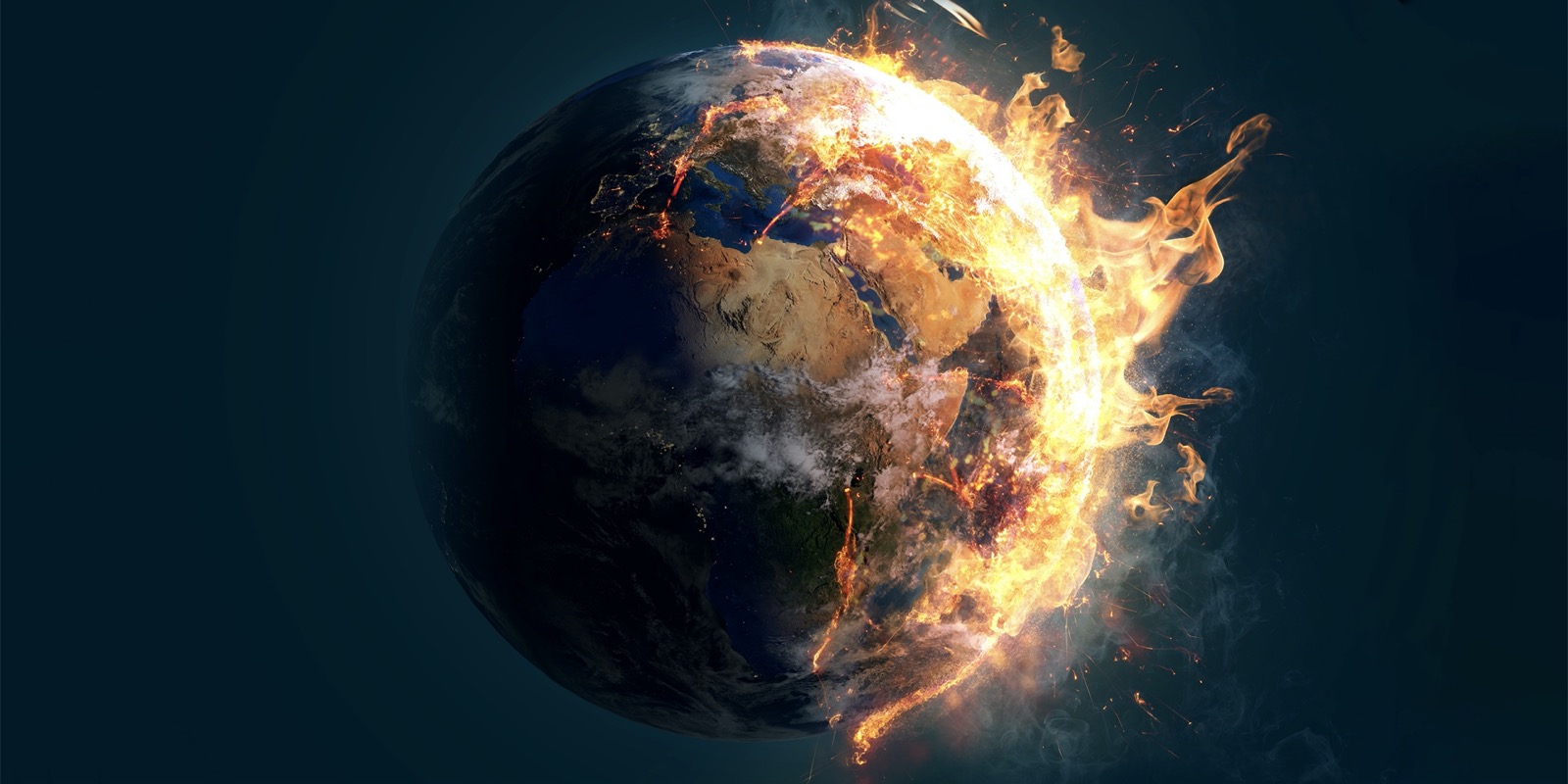As the crisis caused by the new coronavirus deepened and spread, it was to be expected that the phenomenon would be framed in apocalyptic terms. It is something that tends to occur in such contexts.
In this situation, I believe it is appropriate to ask ourselves where we stand between apocalyptic hysteria and eschatological desensitisation. After all, is there an end? And, if so, which version of The End is true?
The end of the world and the present generation
Whether one believes it to be real or not, the biblical story of the universal flood reveals a reality that is easily noticeable in all generations of human history: many do not believe that the end is coming in their generation and only a minority adheres to this prediction.
Take just three examples in support of the above statement: one ancient, one modern and one recent. When the hour of ancient Sodom arrived, Lot, who was different from the inhabitants of the cursed city, is notified of the fate that is to befall Sodom and goes to his sons-in-law to warn them to leave. Their reaction is significant: “His sons-in-law thought he was joking” (Genesis 19:14).
Mirroring this story, Søren Kierkegaard, the mid-19th century Danish philosopher and theologian imagined the end of the world like this: “A fire broke out behind the stage of a theatre. The clown took to the stage to warn the audience; they thought it was a joke and applauded. He repeated the warning, they cheered even louder. This is exactly how I think the world will end: amid the applause of some distracted people who think it’s a joke.”[1]
In March 2012, an online survey was conducted in which over 16,000 adults from several countries participated. They answered the question: “To what extent do you agree with the statement, ‘I think the world will end in my lifetime?’”. Turkey and the United States had the highest score: 22% of participants from these countries answered in the affirmative. At the opposite end were three of the most civilised European countries: Great Britain (8%), Belgium (7%) and France (6%). The results are all the more telling as 2012 had been a candidate for the apocalypse: according to some cyclical calculations of the Mayan calendar the end of the world was to come on December 21 of that year. Although not confirmed by experts, these calculation had an impact on the collective consciousness that usually feeds on information from uncritical or non-academic sources (especially since in 2009 the science fiction film 2012 was released, on the same topic).
Despite the fact that few tend to believe that the end of the world is an event they will experience, the apocalyptic phenomenon continues to enjoy popularity. In the following article we will take a closer look at some of the most popular apocalyptic patterns.
End models
End times imagery differs according to its source. We will use these different sources as a reference system for our classification. Published in 2019, the book End Times: A Brief Guide to the End of the World, by Bryan Walsh[2], science and environmental correspondent for Time magazine for more than 15 years, addresses several scenarios of the end of the world. About a month after the book was published, Walsh was interviewed about these scenarios and was asked to give each scenario a rating from 1 to 10 on how destructive they would be in the event they happened.
The end of man by self-destruction
This category of scenarios includes global warming, the threat from artificial intelligence, food contamination and disease.
Global warming was rated 3 by Walsh, because he believes it would not be able to destroy the human race itself, but only when corroborated with several of its effects. In the scientific world, apocalyptic predictions about global warming are generally considered purely speculative, although it is acknowledged that it could have some utility in raising public awareness.[3]
More recently, however, the opposite effect has been observed: the worse the predictions are regarding global warming, the more the problem is denied because it is perceived as a threat to entrenched values and beliefs.[4]
The threat of artificial intelligence getting out of control was rated 6, because it would happen much quicker than global warming, although currently it is not a definite possibility. The development of self-parking cars, Walsh remarks, gave companies the opportunity to observe how difficult it is to replicate the complexity of the human being in a robot.
The threat of food contamination is rated 3. According to Walsh, about 48 million people get sick each year from contaminated food. Global food circulation may intensify this problem, but the danger is not total. There are control rules, and they cannot be violated all at once.
Disease as the cause of the end of the world receives a rating of 2. It is the most significant cause of mortality, but it seems to have some natural limits: the deadliest diseases are not very contagious; the most contagious are not fatal.
James Pile and Steven Gordon discuss pandemic flu and ask in the title of their article: “When will the apocalypse come?”. The question receives only an intuitive answer: never, as long as the preparations and precautions—which are so handy to us to drastically limit the mortality of a pandemic—are carefully planned and organised.[5] In an article on the Black Death and the end of the world, Gert Brieger stated: “Our era is not the first to perceive the real possibility of an end of the world. But what is unique to our case is our fate is truly in our hands.”[6] Brieger made this proclamation in 1984. Almost 40 years later, these words ring all the truer, given the technical and scientific advances that have taken place since then.
The end of man by natural disaster
Two scenarios fall into this category: the possibility of a collision with a large asteroid, and supervolcanoes. The asteroid scenario scores 2 on the probability scale. It doesn’t seem to be that bad, given the progress of science. Their proximity to Earth can be detected much earlier than an earthquake, for example, and with current technology could even be hijacked.[7]
On Earth, in addition to ordinary volcanoes, there are also supervolcanoes. Walsh rates their ability to destroy the planet at 6.
Supervolcanoes have the potential to lower temperatures globally, scatter a 1-meter layer of ash over very large areas, dim sunlight for years, and result in the depletion of food all over the Earth within two months. But it seems that, at least in areas where money is not an issue, there are intervention and prevention policies to stave off such catastrophes. It seems that what is within our control is having a good knowledge of volcanic sites and predicting the behaviour of volcanoes.[8] But the eruptions themselves cannot be prevented.
The end of man by extra-terrestrial invasion
This is where the alien invasion scenario comes in. Walsh does not give it any rating, since we have no terms of comparison. We have no scientific evidence of life outside our planet (nor evidence that it does not exist).[9] But Walsh says that if something came from beyond, we would have no chance, unlike movies in which people successfully combat space invasions.
The end of man as an imaginary paradigm
As can be expected, there is an opposite reaction to all of the above. Instead of imagining multiple scenarios for our end, there is a category of audience that sees in the attempts to identify apocalypse scenarios only a myth of reinvention. Romanian historian Lucian Boia, in his book, Sfârșitul lumii (The End of the World), posits that mankind sees many ways the world might end, but these are complete only in an imaginary world, not in reality.[10] The psychological need to start over is what seems to be behind this. The effect of hysteria is desensitisation. In the end, nothing seems to be coming—it’s just our need for resurrection.
The post-apocalyptic view spread easily in recent years (see the recent film industry[11]). It claims, in essence, that any disaster that may come will simply be a new start with the few that remain. The total end to mankind seems to be just a psychological construct, with no basis in real life.
The end from a biblical perspective
In the following, I propose a balanced vision of the end of the world. Often the balance is not attractive, because it does not seem exciting or soothing. But the vision proposed below, while realistic, is no less challenging.
The paradigm of the universal flood
Let’s go back to the biblical record of the flood. When it was over, God, who is described as the ultimate source of that cataclysm, declares: “Never again will I curse the ground because of humans…. And never again will I destroy all living creatures, as I have done. As long as the earth endures, seedtime and harvest, cold and heat, summer and winter, day and night will never cease” (Genesis 8:21-22, NIV).
The expression “As long as the earth endures” (literally, “all the days of the earth”) suggests that the planet is not immortal (“heaven and earth will pass away,” Jesus said in Mark 13:31 and Matthew 24:35). Elsewhere in Genesis, the expression “all the days” refers to human life (3:17; 9:29)[12]. Like human beings, the planet is transient.[13]
The expression “As long as the earth endures” (literally, “all the days of the earth”) suggests that the planet is not immortal (“heaven and earth will pass away,” Jesus said in Mark 13:31 and Matthew 24:35). Elsewhere in Genesis, the expression “all the days” refers to human life (3:17; 9:29)[14]. Like human beings, the planet is transient.[15]
According to the Judeo-Christian tradition, the earth will never again be hit by a natural disaster of universal proportions. The planet will not perish because of extreme global phenomena of nature.
In fact, the New Testament tells us that this uninterrupted cyclicity of the Earth will be interpreted by some as meaning that the end of the planet will not take place (2 Peter 3:3-4)[16].
But the apostle Peter turns the biblical flood into a paradigm of apocalyptic destruction by fire (see also the case of Sodom and Gomorrah; Genesis 19)[17]: “But the heaven we see now and the earth we live on now have been kept by His word. They will be kept until they are to be destroyed by fire. They will be kept until the day men stand before God and sinners will be destroyed. (2 Peter 3:7, NLT).”
In other words, although another flood will not hit the planet during its history, the fact that such a cataclysm once took place is proof that the planet will be destroyed in the end by fire.[18] Destroying the world by fire is not an exclusively Christian idea. It appears in Jewish, Qumran, apocalyptic, apocryphal literature and in early Christian and Roman writings.[19]
But where will the disaster come from?
The extinction of humanity will come from outside the planet
The final day of the earth is presented in the Bible as being marked by God’s judgement on the wicked. As in the flood, the cause of the conflagration is the moral backwardness of men, and the source of destruction is divine judgement. Peter describes the event as follows: “…the heavens will pass away with a great noise, and the elements will melt with fervent heat; both the earth and the works that are in it will be burned up” (2 Peter 3:10, NKJV). The language used here emphasises the total nature of the destruction.[20]
To this picture we can add the symbolic description in the biblical book of Revelation, which, in verses 19 to 21 of chapter 19, recounts how the kings of the earth and their armies gather to make war against Christ and His army. Biblical scholars identify this final conflict as the war at Armageddon (Revelation 16:16).[21] As “King of kings and Lord of lords” (19:16), Christ overcomes, in two acts: first, the governing structures of the end-time political-religious alliance (the beast and the false prophet) are annihilated.[22] Then people are “slain with the sword of him that sat upon the horse” (19:21). The sword in the mouth of Christ must be interpreted metaphorically. In the Apocrypha (Psalm 17:24), in rabbinic literature (1Q28 = 1QRule of the Blessings 5:24-25), and in the biblical canon (Hebrews 4:12) we find the sword incorporating the qualities of God’s Word.[23] Apparently, although the language used is military, the idea is that once God speaks, there will be no fighting.[24] Here the Word that originally spoke life into existence (Genesis 1; John 1:1-3) now has the opposite effect, bringing death.
An unpredictable end
The third principle of biblical eschatology that deserves our attention is its surprising character. Christ’s return / the end of the world will come like a thief in the night, the New Testament repeats (1 Thessalonians 5:2; 2 Peter 3:10a; Revelation 16:15). So, no matter how hard we try to read into our times what is happening, the grand finale will be unexpected. Of course there is a difference between those who prepare and those who do not, but it will nevertheless be a surprise for everyone (see the parable of the ten virgins, Matthew 25:1-13), because none of the categories knows the exact time of the end (Matthew 24:36). It’s just that those who are prepared will not remain on the wrong side of history.
Several researchers identify in the apocalypse a leitmotif: counterfeiting. Christ is replicated by the Antichrist[25], the miracles of true prophets are reproduced by pseudo-miracles[26], and the biblical system of values is falsified. It seems quite clear that the end of the world will be one clothed in religion, a false religion.[27] In this sense, the metaphor of the thief acquires new meaning. Christ will come as a thief not only in the sense of the unexpected character of His return, but also because falsehood takes the place of truth. Christ said it this way: “For false messiahs and false prophets will appear and perform great signs and wonders to deceive, if possible, even the elect” (Matthew 24:24). The culmination of these counterfeits will be the reproduction of the second coming. Christ will appear to have arrived on Earth, and mankind will accept the Antichrist messianic figure as the true Saviour (2 Thessalonians 2:9-12). That is why Christ is described at His coming as “the true one” (Revelation 19:11). But you can’t really recognise in the last hour what you haven’t recognised before.
Final reflections
The importance of the eschatological surprise is that it forces us to always be ready for the end, even if it is delayed for generations. In the same vein, it makes us more balanced, unlikely to speculate that any reversal of the usual order (including that caused by COVID-19) is a sign of the end times. The end of the world is not as predictable as some modern “prophets” would like us to believe.
Also, the surprising character of the eschaton urges us to look elsewhere for the motivation for moral experience. In other words, we do not keep the law of God for fear that we are living in the last days of history and do not want to perish with the world. We keep the law for its intrinsic value. In holiness there is a beauty that remains to be discovered.
Last, but not least, the preparation for the end should not be like cramming for an exam just before you are due to write. If today, on a spiritual and individual level, Christ is perceived as less than who He claims to be, the difference between the real Christ and the Antichrist will be almost imperceptible. We will only recognise Him if we truly know Him now.
The first part of the previous statement was explained by Romanian poet Mihai Eminescu in the penultimate stanza of the poem dedicated to Christ, “Man and God”:
Today, the artist conceives you as a king on his throne,
But his vain heart doesn’t follow his elegant handwriting…
By the spirit of his century had been pierced his heart
And the perception in his mind is that you are a Man, not God.
Laurenţiu-Florentin Moţ, PhD, is associate professor and rector of Adventus University.



















